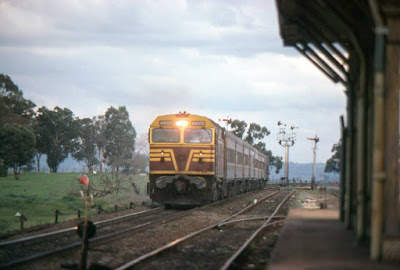The river bridge was completed in 1879, and trains were able
to run to “South Wagga Wagga”, and later to Albury. The engine facilities were relocated. The name “Bomen” was adopted in 1882. The
town that had come about due to the end of the railway line faded away,
as almost everyone moved south to Wagga Wagga.
Bomen station survived as a crossing loop/staff exchange,
loading ramp, and a large abattoir. Wagga City council was keen to grow Bomen as
an industrial estate in the 1970s.
A rough timeline.
1952 signal diagram shows the abattoir, including sidings
for stock unloading
1975. Weekly notices
have the establishment of a cannery (now run by Heinz), with a siding off the
abattoir siding. Freight rates for
shunting this siding are $2 a wagon
1975. Weekly notices also mention a siding to “Hollanders”,
which I understand was a leather tanning operation. Freight rates for this
siding were $2.50 a wagon. (The Hollanders siding attaches to the goods siding from behind the station building)
1979. Saleyards
closed in Wagga, and moved to Bomen. A
long siding was established off the “Hollanders” siding
1983. Fuel depot
created (as fuel depots in Wagga were closed), and pointwork also off the “Hollanders”
siding
[Sidings at rear of station building - Left to right beyond the level crossing - , Hollanders, Caltex, Stockyards, and Austrak]
[Shunting the Abattoir siding in the 1980s. Note the cannery siding just visible lower RHS ]
[Stockyard sidings were used for headshunts, and equipment storage]
[Shunting of the oil wagons onto the stockyard siding]
[Hollanders Siding was reasonably lengthy, and had its own right of way through the Bomen estate]
[Hollanders Siding crosses Lewington Street, and ends up at a concrete block loading dock. The tin shed that was once there has long gone]
[Rail approach into Heinz Cannery. Inside the building, the track still exists]
[The Bomen Abattoir has erased the track approach but the loading dock is still intact
As an operational layout, I am going to try and incorporate
as much shunting interest as possible.
And this does mean that I will be stretching the 1970 timeframe a
little. Both the Cannery, and the
Tanning facility will get modelled. The
stockyards, and fuel depot however, are essentially just relocated from Wagga, so I
see no advantage in moving them to Bomen.
The other constraint is space; I
estimate I have around 4 linear metres for Bomen, and at most 600mm wide.
-----------------
By 2017, Bomen has grown considerably. The platform signal box, mechanical signals and
staff exchange platform disappeared in 1983 with the introduction of CTC. A small intermodal facility has been set up
in the yard in the 1990s, Austrak created a concrete sleeper fabrication facility
a short time later. Unfortunately, both
the abattoir and cannery have lost their rail sidings. “Hollanders” relocated within Bomen, although
the long siding and loading dock they used was abandoned. The saleyards sidings saw their last stock
trains by 1989, however, the sidings were retained for rail storage, and
headshunt purposes. The crossing loop was
extended about 5km towards Shepherds Siding.
As oil trains stopped in NSW around 2007, the oil depot saw no rail
activity until last year, when all the wagons were recovered. The oil sidings and stock sidings were pulled
up, and new roadworks for the future Genesee and Wyoming intermodal were
created. And in October 2017, the old
pointwork on the Austrak siding was removed, and new concrete sleepers laid.
The Bomen station and platform remains, heritage listed, although it is
unmanned. The Station masters cottage is
still standing, it too no longer
occupied. The gatekeeper
cottage/gatehouse is long gone, and interestingly, the automatic level crossing
lights and bells that replaced it are themselves out of use due to the
aforementioned intermodal roadworks
[ The trackwork as it exists today. This track was only installed last week (October 2017)( The Caltex oil depot is still visible in the background, but all pointwork has been removed. The siding now serves just one customer - Austrak. The original road at the back of the station, has been reworked onto the old stockyard siding alignment - part of the new intermodal yard -
[Austrak - the siding is to the LHS of the picture]
I want to thank all the people who have supplied me with photos, particularly Rod S, and the Wagga Rail Heritage group, and Pete N for access to records. A number of pictures too by the late Andy Browne have added greatly to my appreciation of Bomen















Great walk through of some recent history Rob. Really enjoyed reading it!
ReplyDeleteHi Rob I might be a bit late just read your info on Bomen the reason I did is that my farther started his railway career there as a fettler in 1940. I didn't really know where Bomen was now I know it was a great read thanks Pete 👍
ReplyDeleteNo Pete, you are not too late. Many of my blog posts are historical - as it sets the stage for the modelling to come. Thank you for sharing your father's story, it all adds extra details to the history.
DeleteAs an aside, I mentioned the G&W intermodal roadworks. Well, as I write this (Aug 2021), the grading of the new lines for the new G&W intermodal is all but complete, and tracklaying will soon be happening.